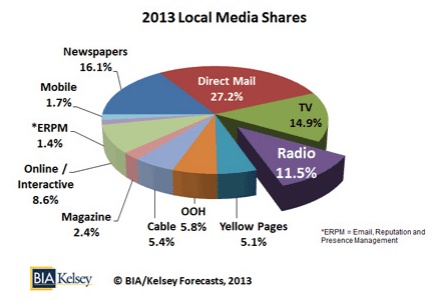 Local media consultancy BIA/Kelsey released a state-of-the-industry report titled “Local Radio Stations Profiles and Trends for 2014 and Beyond.” The study identifies an 11.5% share of local media revenue going to AM/FM. Vice President and Chief Economist Mark Fratrik, who authored the report, summarized the findings with a positive slant: “Local radio is surviving, and in some instances thriving, and poised to compete will in the new marketplace.”
Local media consultancy BIA/Kelsey released a state-of-the-industry report titled “Local Radio Stations Profiles and Trends for 2014 and Beyond.” The study identifies an 11.5% share of local media revenue going to AM/FM. Vice President and Chief Economist Mark Fratrik, who authored the report, summarized the findings with a positive slant: “Local radio is surviving, and in some instances thriving, and poised to compete will in the new marketplace.”
RAIN spoke with Dr. Fratrik about the digital side of radio revenue, and how radio can thrive in an increasingly Internet-oriented market.
RAIN: Your report is optimistic about radio holding its own in a changing marketplace.
 MF: We’re bullish on radio. It takes a different mindset to move into this new [digital] arena. Some radio stations are already thriving. At BIA/Kelsey, we’re very into the whole concept of radio stations being more than just radio stations. [They are] local media companies in many ways, providing access to [new] audiences to their advertising clients. One of the growing ways is certainly online activity, the digital area.
MF: We’re bullish on radio. It takes a different mindset to move into this new [digital] arena. Some radio stations are already thriving. At BIA/Kelsey, we’re very into the whole concept of radio stations being more than just radio stations. [They are] local media companies in many ways, providing access to [new] audiences to their advertising clients. One of the growing ways is certainly online activity, the digital area.
RAIN: The headline metric of the report is the 11.5% percent share of local media going to radio. Is there a breakout of how much is digital advertising?
MF: 11.5% was over the air, and 0.4% was online.
RAIN: When there’s a disparity like that, there are two ways to interpret it. One interpretation is that the online side is underperforming. A more optimistic view is that there’s great upside for digital.
MF: Glass half full, glass half empty, right? It’s interesting to contrast with newspapers. With newspapers you get a larger percentage of their advertising is online. Newspapers started earlier, and are being forced to go online because print is declining precipitously.
I think for radio it’s an opportunity. Radio’s core revenues are solid. It’s not great growth — one-to-two percent a year. But digital represents great potential. Maybe radio was slow to move into [the digital space], hoping that over-the-air would rebound. But I really do believe that radio has great assets in the local marketplace that can lead to substantial revenues.
RAIN: Are there other challenges with a new medium, in addition to speed of adoption? You might have to develop new creative formats for advertisers, and to educate advertisers about new value propositions.
MF: I agree, but that doesn’t explain why newspapers have been able to make greater inroads into the online game. I would argue another reason: Transforming your entire staff to thinking beyond just over-the-air.
RAIN: Do you think newspapers have been more desperate?
MF: Very much so. [Many local papers have reduced publishing] to just three days a week. Necessity is the mother of invention.
RAIN: Do you have a view about how broadcast radio can build up the digital revenue side?
MF: Streaming is part of it. [Also] getting more traffic to the station websites. There’s no reason why radio stations can’t sell video advertising on their websites.
I also think broadening services to include what is collectively called “digital agency” activities. Being an advisor to small and medium businesses in the local marketplace. Explaining SEO, website development, how to run daily deals, what to do with your Facebook page. Broadcasters, with their local sales staffs, can get into these areas and work with local businesses. Some radio groups are [already] becoming digital agencies, providing other services to their advertiser clients.
RAIN: So the station would act as a local consultancy about digital realities.
MF: Right. And obviously, digital advertising would be part of it. But it’s not the only part. When you walk in as a consultant, you have more credibility. Newspapers are doing it, and some local magazines. Any media company with established local relationships can do it. The only thing limiting radio is creativity, and radio people have a lot of creativity.
